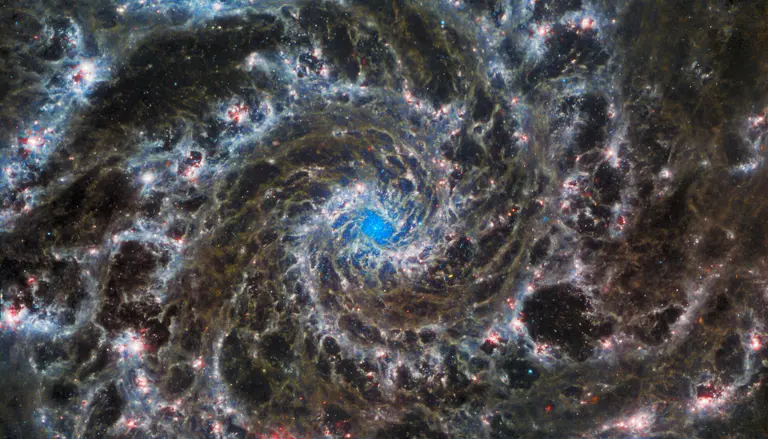Return to All Folder Listing

| Filename | Flickr nasawebbtelescope_52324826014_10db2ac268_o CC-BY NASA.jpg |
|---|---|
| Desc | This image from the NASA/ESA/CSA James Webb Space Telescope shows the heart of M74, otherwise known as the Phantom Galaxy. Webb’s sharp vision has revealed delicate filaments of gas and dust in the grandiose spiral arms which wind outwards from the centre of this image. A lack of gas in the nuclear region also provides an unobscured view of the nuclear star cluster at the galaxy's centre. M74 is a particular class of spiral galaxy known as a ‘grand design spiral’, meaning that its spiral arms are prominent and well-defined, unlike the patchy and ragged structure seen in some spiral galaxies. The Phantom Galaxy is around 32 million light-years away from Earth in the constellation Pisces, and lies almost face-on to Earth. This, coupled with its well-defined spiral arms, makes it a favourite target for astronomers studying the origin and structure of galactic spirals. Webb gazed into M74 with its Mid-InfraRed Instrument (MIRI) in order to learn more about the earliest phases of star formation in the local Universe. These observations are part of a larger effort to chart 19 nearby star-forming galaxies in the infrared by the international PHANGS collaboration. Those galaxies have already been observed using the NASA/ESA Hubble Space Telescope and ground-based observatories. The addition of crystal-clear Webb observations at longer wavelengths will allow astronomers to pinpoint star-forming regions in the galaxies, accurately measure the masses and ages of star clusters, and gain insights into the nature of the small grains of dust drifting in interstellar space.Hubble observations of M74 have revealed particularly bright areas of star formation known as HII regions. Hubble’s sharp vision at ultraviolet and visible wavelengths complements Webb’s unparalleled sensitivity at infrared wavelengths, as do observations from ground-based radio telescopes such as the Atacama Large Millimeter/submillimeter Array, ALMA. By combining data from telescopes operating across the electromagnetic spectrum, scientists can gain greater insight into astronomical objects than by using a single observatory — even one as powerful as Webb! MIRI was contributed by ESA and NASA, with the instrument designed and built by a consortium of nationally funded European Institutes (the MIRI European Consortium) in partnership with JPL and the University of Arizona. Links Pan of the Phantom Galaxy Image B Image C |
| Type | Photograph |
| Resolution | 1977 x 1130 |
| License | CC-BY |
| Attribution | NASA |
| Collection | thumbs |
| Folder | 01 Genesis/01 Creation/Day 4 Sun Moon Stars/Photographs |
|
Download Medium Download Large Image Source Browse Folder (Medium Resolution) Browse Folder (High Resolution Show in Interactive Search | |
| The Virtual Bible Snapshot Project provides free artwork to illustrate the Bible and Bible topics, including video, photographs, illustrations, and AI Generated artwork. Creative-Commons licensed and public domain sermon graphics for pastors, teachers and more! Learn more at snapshots.vrbm.org. | |